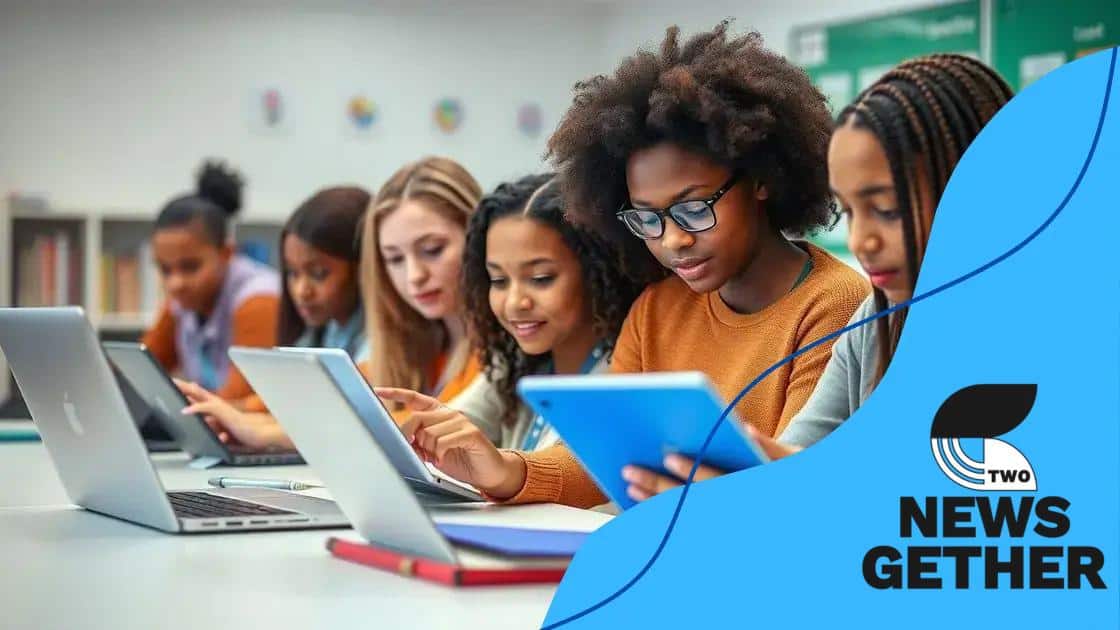How schools are addressing the digital divide in 2025

In 2025, schools are addressing the digital divide by forming partnerships with tech companies, utilizing innovative educational technologies, and encouraging community involvement to ensure equal access to learning resources for all students.
How schools are addressing the digital divide in 2025 is crucial for fostering inclusivity. If you’ve ever wondered how technology can enhance education for all, keep reading.
Understanding the digital divide
Understanding the digital divide is essential for tackling the challenges in modern education. It refers to the gap between those who have easy access to the internet and technology and those who do not. This divide is not just about physical access; it also includes knowledge and skills in using technology effectively.
Many factors contribute to the digital divide. Socioeconomic status, geographic location, and even age can impact how individuals engage with technology. For instance, students in urban areas typically have better access to high-speed internet compared to those in rural regions. This disparity affects learning opportunities and outcomes for countless students.
Key Factors of the Digital Divide
Understanding the components is crucial to bridging the gap. Here are some key factors:
- Infrastructure: Availability of broadband and devices is vital.
- Affordability: The cost of internet access can be prohibitive for low-income families.
- Digital literacy: Skills needed to use technology effectively vary among different populations.
- Policy and support: Government initiatives can either help or hinder access to technology.
Additionally, individuals without strong support systems, such as mentorship or access to educational resources, often struggle more with technology adoption. Educational institutions play a pivotal role in providing resources to help bridge this gap. Schools can implement programs to teach digital literacy, ensuring students are not just consumers of technology but also creators.
By addressing these aspects, we can start to understand and ultimately reduce the digital divide. To create an equitable learning environment, it is vital for schools to focus on comprehensive solutions that include community efforts, partnerships, and policy advocacy.
Innovative solutions in classrooms
Innovative solutions in classrooms are essential to narrow the digital divide and enhance learning experiences. With technology advancing rapidly, educators must adopt new methods and tools to engage students effectively. From interactive learning platforms to virtual reality experiences, the classroom is evolving into a more dynamic environment.
One promising solution involves integrating blended learning models. This approach combines traditional face-to-face instruction with online learning. By doing so, students can learn at their own pace while still receiving personalized guidance from their teachers.
Examples of Innovative Classroom Solutions
Educators are increasingly using various tools to create engaging lessons:
- Smartboards: These interactive boards allow teachers to present information dynamically, enhancing student participation.
- Online Learning Platforms: Websites like Khan Academy and Google Classroom enable access to quality resources and assignments.
- Gamification: Incorporating game elements into lessons can motivate students and make learning fun.
- Virtual Reality (VR): VR can transport students to different environments, deepening their understanding of complex subjects.
Another exciting development is the rise of collaborative projects. Students can now work together across distances using various digital tools. This collaboration fosters teamwork and problem-solving skills, which are vital for success in the modern workforce. By utilizing these innovative solutions, teachers can create a more inclusive environment, ensuring that every student has the opportunity to thrive.
The use of artificial intelligence in classrooms is also gaining traction. AI can help customize learning experiences based on individual student needs, making education more accessible. Teachers can leverage data analytics to understand student performance and tailor their instruction accordingly.
Partnerships with tech companies

Partnerships with tech companies are reshaping the landscape of education, making it easier for schools to access the latest resources and tools. These collaborations can help close the digital divide by providing students with enhanced learning experiences. When schools work together with technology providers, they can introduce innovative solutions tailored to their unique needs.
One effective approach in these partnerships is the integration of educational software into the classroom. This software often includes interactive lessons and assessments, allowing teachers to track student progress in real time. Furthermore, tech companies can provide training for educators, ensuring that they are comfortable using new tools.
Benefits of Partnerships with Tech Companies
Such collaborations offer numerous advantages:
- Access to Resources: Schools gain access to advanced tools that they might not afford otherwise.
- Tailored Solutions: Tech companies can customize products to meet the specific requirements of different educational environments.
- Enhanced Professional Development: Training sessions can equip teachers with the skills they need to effectively utilize technology.
- Continuous Support: Ongoing support from tech experts helps schools overcome any challenges they face.
Moreover, these partnerships can lead to innovative pilot programs. For instance, some schools have successfully implemented coding classes or robotics clubs, driven by funding and resources from tech companies. These initiatives not only spark student interest but also give them valuable skills for the future.
By working with tech companies, schools can create a more engaging learning atmosphere. Increased access to technology fosters collaboration among students and encourages creativity. As a result, students are better prepared for the demands of a technology-driven world.
Community involvement in bridging gaps
Community involvement plays a vital role in bridging gaps related to the digital divide. When local organizations, businesses, and families work together, they create a supportive network that enhances educational opportunities for students. This active participation helps ensure that all students have access to the technology and resources they need to succeed.
One effective way communities can contribute is by organizing technology drives. These initiatives collect donations of computers, tablets, and other tech devices for students in need. Schools can then distribute these devices, allowing more students to participate in digital learning. Additionally, community members can volunteer their time to teach digital literacy classes.
Benefits of Community Involvement
The advantages of community support are significant:
- Access to Technology: Local organizations can help provide students with necessary devices to facilitate learning.
- Skill Development: Community members can share their expertise by leading workshops on using technology effectively.
- Networking Opportunities: Students gain connections with professionals who can provide mentorship or internship opportunities.
- Increased Awareness: Engaging the community raises awareness about the challenges students face in accessing technology.
Moreover, collaborative events like hackathons or coding camps can inspire creativity among students. These activities encourage teamwork and problem-solving while helping students become comfortable with technology. Schools that actively involve their communities can create a more inclusive environment, enabling every student to thrive.
Furthermore, partnerships with local businesses can enhance educational resources. When tech companies engage with community initiatives, they can provide valuable tools and expertise. These collaborations allow schools to implement advanced programs that address specific needs. By leveraging community involvement, schools can effectively combat the digital divide and improve educational outcomes for all.
Future trends in educational technology
Future trends in educational technology are shaping how students learn and how teachers instruct. As technology continues to evolve, schools are adopting new tools to make education more engaging and effective. Embracing these trends can help bridge the digital divide and ensure that all students have access to quality education.
One significant trend is the growth of personalized learning. With the help of AI and data analytics, educators can tailor lessons to meet each student’s individual needs. This approach allows students to learn at their own pace and focus on areas where they need improvement.
Key Trends in Educational Technology
Several emerging trends are likely to define the future of education:
- Artificial Intelligence: AI can assist in grading, providing feedback, and offering personalized recommendations for students.
- Virtual and Augmented Reality: These technologies can create immersive learning experiences, making complex concepts easier to understand.
- Online Collaboration Tools: Platforms like Google Workspace and Microsoft Teams enhance collaboration among students, even from a distance.
- Gamification: Incorporating game elements into lessons can increase student engagement and motivation to learn.
Additionally, the emphasis on social-emotional learning is gaining traction. Technology can support mental health initiatives by providing resources and access to counseling services. When technology is integrated thoughtfully, it can create a supportive learning environment where students feel safe and engaged.
Moreover, the integration of blockchain technology in education can offer secure and transparent methods for tracking student achievements and credentials. This could simplify the process of transferring credits between institutions and offer better security for student data.
As we move into the future, addressing the digital divide remains a priority. Schools, communities, and technology companies must unite to create equal access to educational resources. By adopting innovative solutions, fostering partnerships, and encouraging community involvement, we can ensure that every student has the opportunity to succeed. Technology will continue to play a vital role in shaping education, making it essential for all stakeholders to work together for a brighter, more inclusive future.
FAQ – Frequently Asked Questions about Addressing the Digital Divide in Education
What is the digital divide?
The digital divide refers to the gap between individuals who have access to technology and those who do not, affecting their educational opportunities.
How can communities help bridge the digital divide?
Communities can organize technology drives, provide training in digital literacy, and support local initiatives that enhance access to educational resources.
What role do tech companies play in education?
Tech companies can partner with schools to provide necessary tools, resources, and training to help improve the educational experience for students.
What future trends should we expect in educational technology?
Future trends include personalized learning through AI, greater use of virtual reality, and increased emphasis on social-emotional learning.






